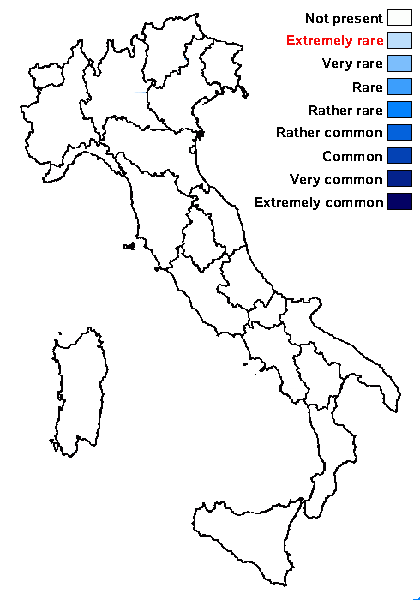Sclerophora farinacea (Chevall.) Chevall
Fl. gén. env. Paris, 1: 315, 1826. Basionym: Fulgia farinacea Chevall. - J. Phys. Chim. Hist. nat. Arts, 94: 57, 1822
Synonyms: Coniocybe nivea var. farinacea (Chevall.) Syd.
Distribution:
Description: Thallus endosubstratic, poorly evident. Apothecia stalked, pin-like, 0.7-1.2 mm high, the stalk 0.09-0.14 thick, medium brown, epruinose, glossy, consisting of hyaline, non-sclerotized, strictly periclinally arranged, sparingly branched hyphae. Capitulum broadly obovate to lenticular, 0.3-0.4 mm across, the mazaedium sometimes slightly pruinose in older apothecia, pale ochraceous, the mazaedial pruina of semi-mature apothecia K+ deeper violet red, N+ yellowish red, the ochraceous mazaedial pruina of mature apothecia K+ reddish, N-; mazaedium densely inspersed with minute, dark yellow crystals which also adhere to spores and paraphyses. Exciple forming a distinct, 30-110 µm thick collar surrounding the stalk at the base of the capitulum, of hyaline, radiating, apically sparingly branched, 1-1.5 µm thick hyphae; wedge-like agglomerations of colourless crystals penetrate into the exciple forming a more or less continuous layer over its surface, appearing as a white, granular, crystalline pruina; hypothecium pale yellowish brown, with a slightly convex upper surface, 70-100 µm high, formed by intricately interwoven, c. 1 µm thick hyphae. Asci cylindrical or cylindrical-clavate, formed singly and dissolving early, without apical structures, with 1-seriately arranged ascospores, 27-32 x 5-6 µm. Ascospores 1-celled, globose, hyaline, 7-8 µm wide, the wall with a verrucose ornamentation. Photobiont trentepohlioid. Spot tests: the yellow pruina of the ascomata is K-, whereas the violet-red pruina dissolves in K forming plate-like, violet red crystals. Chemistry: thallus without lichen substances.Note: a very rare, mainly northern species with a circum-temperate distribution, growing on the subneutral bark of old deciduous trees in ancient forests; to be looked for in Italy.
Growth form: Crustose
Substrata: bark
Photobiont: Trentepohlia
Reproductive strategy: mainly sexual

Predictive model
Growth form: Crustose
Substrata: bark
Photobiont: Trentepohlia
Reproductive strategy: mainly sexual

Predictive model
 INDEX FUNGORUM
INDEX FUNGORUM
 GBIF
GBIF



